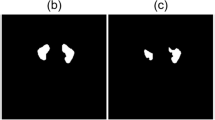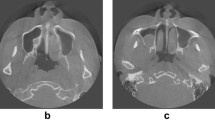Abstract
Purpose
The analysis of the maxillary sinus (MS) can provide an assessment for many clinical diagnoses, so accurate CT image segmentation of the MS is essential. However, common segmentation methods are mainly done by experienced doctors manually, and there are some challenges such as low efficiency and precision. As for automatic methods, the initial seed points and adjustment of various parameters are required, which will affect the segmentation efficiency. Thus, accurate, efficient, and automatic segmentation method of MS is critical to promote the clinical application.
Methods
This paper proposed an automatic CT image segmentation method of MS based on VGG network and improved V-Net. The VGG network was established to classify CT slices, which can avoid the failure of CT slice segmentation without MS. Then, we proposed the improved V-Net based on edge supervision for segmenting MS regions more effectively. The edge loss was integrated into the loss of the improved V-Net, which could reduce region misjudgment and improve the automatic segmentation performance.
Results
For the classification of CT slices with MS and without MS, the VGG network had a classification accuracy of 97.04 ± 2.03%. In the segmentation, our method obtained a better result, in which the segmentation Dice reached 94.40 ± 2.07%, the Iou (intersection over union) was 90.05 ± 3.26%, and the precision was 94.72 ± 2.64%. Compared with U-Net and V-Net, it reduced region misjudgment significantly and improved the segmentation accuracy. By analyzing the error map of 3D reconstruction, it was mainly distributed in ± 1 mm, which demonstrated that our result was quite close to the ground truth.
Conclusion
The segmentation of the MS can be realized efficiently, accurately, and automatically by our method. Meanwhile, it not only has a better segmentation result, but also improves the doctor’s work efficiency, which will have significant impact on clinical applications in the future.






Similar content being viewed by others
References
Giacomini G, Pavan ALM, Altemani JMC, Duarte SB, Fortaleza CMCB, Miranda JRA, De Pina DR (2018) Computed tomography-based volumetric tool for standardized measurement of the maxillary sinus. PLoS ONE 13(1):e0190770
Aksoy EA, Özden SU, Karaarslan E, Ünal ÖF (2014) Tanyeri H (2014) Reliability of high-pitch ultra-low-dose paranasal sinus computed tomography for evaluating paranasal sinus anatomy and sinus disease. J Craniofac Surg 25(5):1801–1804
Pallanch JF, Yu L, Delone D, Robb R, Holmes DR 3rd, Camp J, Edwards P, McCollough CH, Ponikau J, Dearking AC, Lane J, Primak A, Shinkle A, Hagan J, Frigas E, Ocel JJ, Tombers N, Siwani R, Orme NM, Reed KB, Jerath N, Dhillon R, Kita H (2013) Three-dimensional volumetric computed tomographic scoring as an objective outcome measure for chronic rhinosinusitis: clinical correlations and comparison to Lund-Mackay scoring. Int Forum Allergy Rhinol 3(12):963–972
Berberi A, Bouserhal L, Nader N, Assaf RB, Nassif NB, Bouserhal J, Salameh Z (2015) Evaluation of three-dimensional volumetric changes after sinus floor augmentation with mineralized cortical bone allograft. J Maxillofac Oral Surg 14(3):624–629
Starch-Jensen T, Jensen JD (2017) Maxillary sinus floor augmentation: a review of selected treatment modalities. J Oral Maxillofac Res 8(3):e3
Demir UL, Akca ME, Ozpar R, Albayrak C (2015) Anatomical correlation between existence of concha bullosa. Surg Radiol Anat 37:1093–1098
Andersen TN, Darvann TA, Murakami S, Larsen P, Senda Y, Bilde A, Buchwald C, Kreiborg S (2018) Accuracy and precision of manual segmentation of the maxillary sinus in MR images-a method study. Br J Radiol 91(1085):20170663
Gomes AF, Gamba TO, Yamasaki MC, Groppo FC, Neto FH, Possobon RF (2018) Development and validation of a formula based on maxillary sinus measurements as a tool for sex estimation: a cone beam computed tomography study. Int J Legal Med 133:1241–1249
Shi H, Scarfe WC, Farman AG (2006) Maxillary sinus 3D segmentation and reconstruction from cone beam CT data sets. Int J Comput Assist Radiol Surg 1:83–89
Jinda-apiraksa A, Ongy SH, Hiewy LT, Foongz KWC, Kondo T (2009) A segmentation technique for maxillary sinus using the 3-D level set method. In: Proceedings of the IEEE region 10 conference, pp 1–6
Shelhamer E, Long J, Darrell T (2015) Fully convolutional networks for semantic segmentation. IEEE Trans Pattern Anal Mach Intell 39(4):640–651
Ronneberger O, Fischer P, Brox T (2015) U-Net: convolutional networks for biomedical image segmentation. In: Proceedings of the international conference on medical image computing and computer-assisted intervention, Springer, Cham, pp 234–241
Milletari F, Navab N, Ahmadi SA (2016) V-Net: fully convolutional neural networks for volumetric medical image segmentation. In: Proceedings of the IEEE fourth international conference on 3D vision, pp 565–571
Tang H, Chen X, Liu Y, Lu Z, You J, Yang M, Yao S, Zhao G, Xu Y, Chen T, Liu Y, Xie X (2019) Clinically applicable deep learning framework for organs at risk delineation in CT images. Nat Mach Intell 1:480–491
Xu J, Jing M, Wang S, Yang C, Chen X (2019) A review of medical image detection for cancers in digestive system based on artificial intelligence. Expert Rev Med Devices 16(10):877–889
Simonyan K, Zisserman A (2015) Very deep convolutional networks for large-scale image recognition. In: Proceedings of the international conference on learning representations, pp 1–14
Xu Z, Wu Z, and Feng J (2018) CFUN: combining faster R-CNN and U-Net network for efficient whole heart segmentation. arXiv preprint, arXiv:1812.04914
Zimmermann RS, Siems JN (2019) Faster training of Mask R-CNN by focusing on instance boundaries. Comput Vis Image Underst 188:102795
Kervadec H, Bouchtiba J, Desrosiers C, Granger É, Dolz J, Ayed IB (2019) Boundary loss for highly unbalanced segmentation. In: Proceedings of the international conference on medical imaging with deep learning (MIDL), pp 285–296
Ioffe S, Szegedy C (2015) Batch normalization: accelerating deep network training by reducing internal covariate shift. In: Proceedings of the international conference on international conference on machine learning, pp 448–456
Ham S, Lee A, Park J, Byeon Y, Lee S, Bae M, Kim N (2018) Multi-structure segmentation of hard tissues, maxillary sinus, mandible, mandibular canals in cone beam CT of head and neck with 3D U-Net. In: Proceedings of the international conference on medical imaging with deep learning (MIDL), pp 1–3
Acknowledgements
This work was supported by grants from National Key R&D Program of China (2017YFB1302900), National Natural Science Foundation of China (81971709; 81828003; M-0019; 82011530141), the Foundation of Ministry of Education of China Science and Technology Development Center (2018C01038), the Foundation of Science and Technology Commission of Shanghai Municipality (19510712200), and Shanghai Jiao Tong University Foundation on Medical and Technological Joint Science Research (ZH20182DA15;YG2019ZDA06;ZH2018QNA23).
Author information
Authors and Affiliations
Corresponding author
Ethics declarations
Conflict of interest
The authors declare that they have no conflict of interest.
Ethical approval
All procedures performed in studies involving human participants were in accordance with the ethical standards of the institutional and/or national research committee and with the 1964 Helsinki Declaration and its later amendments or comparable ethical standards.
Informed consent
Informed consent was obtained from all individual participants included in the study.
Additional information
Publisher's Note
Springer Nature remains neutral with regard to jurisdictional claims in published maps and institutional affiliations.
Rights and permissions
About this article
Cite this article
Xu, J., Wang, S., Zhou, Z. et al. Automatic CT image segmentation of maxillary sinus based on VGG network and improved V-Net. Int J CARS 15, 1457–1465 (2020). https://doi.org/10.1007/s11548-020-02228-6
Received:
Accepted:
Published:
Issue Date:
DOI: https://doi.org/10.1007/s11548-020-02228-6




